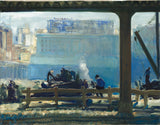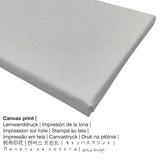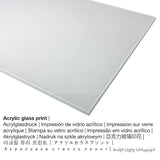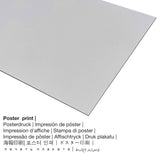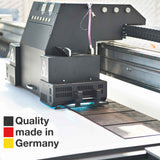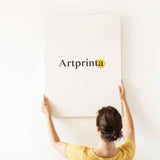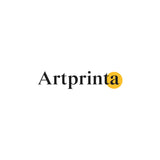George Bellows, 1909 - Blue Morning - mbipụta nka mara mma
Ụtụ gụnyere. Mbupu gbakọrọ na ndenye ọpụpụ.
Họrọ ihe gị
Nchịkọta nhọrọ ndetu ngwaahịa na-enye gị ohere ịhọrọ nha na akụrụngwa masịrị gị. Ka ị kwekọọ n'ihe ị chọrọ nke ọma, ị nwere ike họrọ n'ime nhọrọ nhazi ngwaahịa ndị a:
- Mbipụta akwụkwọ mmado (akwa akwa akwa): The Artprinta poster is a UV printed canvas paper with a slight texture on the surface. Please bear in mind, that depending on the absolute size of the canvas poster print we add a white margin of around 2-6cm around the painting in order to facilitate the framing with your custom frame.
- Mbipụta kanvas: The UV printed canvas applied on a wooden stretcher frame. The canvas makes a familiar and comfortable look. Hanging your canvas print: Canvas prints are relatively low in weight, which implies that it is easy to hang up the Canvas print without the help of extra wall-mounts. A canvas print is suited for all types of walls.
- Ihe odide acrylic glass: A glossy print on acrylic glass, often referenced as a an art print on plexiglass, makes the original work of art into beautiful home décor. Besides, the acrylic fine art print forms a good alternative to canvas and aluminidum dibond fine art replicas. The work of art is being printed thanks to state-of-the-art UV printing technology. This makes stunning, vibrant colors. The major advantage of a plexiglass fine art print is that contrasts plus image details will be exposed with the help of the precise gradation.
- Mbipụta ọla (aluminium dibbond): Mbipụta Aluminom Dibond bụ mbipụta nwere mmetụta omimi pụtara ìhè.
Nkwupụta iwu: We try what we can in order to describe the products as closely as possible and to exhibit them visually in our shop. Although, the tone of the print materials and the imprint might differ slightly from the representation on the device's monitor. Depending on your screen settings and the quality of the surface, not all colors can be printed as realisitcally as the digital version depicted here. Since all our art reproductions are processed and printed manually, there may also be minor deviations in the motif's size and exact position.
Ozi mgbakwunye sitere na National Gallery of Art (© Nwebiisinka - National Gallery of Art - Nnukwu osisi nke Art)
Blue Morning is the last of four paintings that George Bellows executed from 1907 to 1909 depicting the construction site of the Pennsylvania Station railroad terminal in New York City. Undertaken by the Pennsylvania Railroad and designed by architectural firm McKim, Mead, & White, Pennsylvania Station (more commonly known as Penn Station) was an enormously ambitious project that helped transform New York into a thriving, modern, commuter metropolis. The building project was of considerable interest to the public, and throughout the years that Bellows worked on these paintings, newspapers and magazines regularly reported on the station’s progress.
The three other paintings in the Penn Station series all focus on the gaping excavation pit, and the two that were publicly exhibited at the time, Pennsylvania Excavation and Excavation at Night, were criticized for their “brutal crudity” and “grim ugliness.” Bellows seems to have addressed these criticisms in Blue Morning, because it is a far more aesthetic and impressionistic rendering of the subject. The unusual backlit composition minimizes the pit and instead focuses on the laborers working in the foreground. McKim, Mead, & White’s partially completed terminal building is visible in the distance.
Nkọwa nke ngwaahịa
Blue Morning bụ onye na-ese ihe George Bellows. The original was made with the size: 86,3 x 111,7 cm (34 x 44 in) and was painted with the techinque of mmanụ na kwaaji. Ọ bụ nke National Gallery of Art's digital art collection, which is the museum of the US-American nation that preserves, collects, exhibits, and fosters an understanding of works of art. With courtesy of: National Gallery of Art, Washington (ikike ngalaba ọha).Ebe E Si Nweta nke ihe osise:. Kedu ihe ọzọ, nhazi nke mmepụta dijitalụ dị n'ime odida obodo format ma nwee oke nke 4: 3, nke pụtara na ogologo bụ 33% ogologo karịa obosara.
Nkọwapụta nka nka
| Aha nke eserese ahụ: | "Blue Morning" |
| Nchịkọta nke ọrụ nka: | sere |
| Okwu mkpokọta: | nkà nke oge a |
| Narị afọ nka: | 20th narị afọ |
| Afọ nka: | 1909 |
| Afọ nka: | ihe karịrị 110 afọ |
| Usoro nka izizi: | mmanụ na kwaaji |
| Akụkụ nke nka nka izizi: | 86,3 x 111,7 cm (34 x 44 na) |
| Egosiputara na: | Nnukwu osisi nke Art |
| Ebe ebe ngosi nka: | Washington DC, Njikota Obodo Amerika |
| Ebe nrụọrụ weebụ ihe ngosi nka: | Nnukwu osisi nke Art |
| Ikikere nke ihe osise: | ngalaba ọha |
| Site n'aka: | National Gallery of Art, Washington |
Ngwaahịa a
| Nkewa ngwaahịa: | nka nka |
| Mmeputakwa: | mmeputakwa n'ụdị dijitalụ |
| Production usoro: | Mbipụta UV ozugbo |
| Nlụpụta: | emepụtara na Germany |
| Stockdị ngwaahịa: | a na-achọ |
| Ngwaahịa were: | foto mgbidi, ime ụlọ |
| Nhazi: | usoro odida obodo |
| Njikwa oyiyi: | ogologo: obosara 4:3 |
| Mmetụta ihe onyonyo: | ogologo bụ 33% ogologo karịa obosara |
| Akụrụngwa ị nwere ike ịhọrọ: | Mbipụta kwaaji, mbipụta enyo acrylic (nwere ezigbo mkpuchi iko), mbipụta akwụkwọ mmado (akwụkwọ kwaaji), mbipụta ọla (aluminium dibbond) |
| Nhọrọ nha nke akwa akwa n'elu etiti ihe na-agbatị (mbipụta kwaaji): | 40x30cm - 16x12", 80x60cm - 31x24", 120x90cm - 47x35", 160x120cm - 63x47" |
| Mbipụta iko acrylic (nke nwere ezigbo mkpuchi iko): | 40x30cm - 16x12", 80x60cm - 31x24", 120x90cm - 47x35", 160x120cm - 63x47" |
| Ụdị akwụkwọ mmado (akwụkwọ kwaaji) dị iche iche: | 40x30cm - 16x12", 80x60cm - 31x24", 120x90cm - 47x35" |
| Mbipụta aluminom (ihe alumini debond ihe): | 40x30cm - 16x12", 80x60cm - 31x24", 120x90cm - 47x35" |
| Nhazi mbipụta nka: | agunyeghi |
Ozi izugbe gbasara onye na-ese ihe
| Aha onye nka: | George Bellows |
| Aliases: | Bellows, geo bellows, geo. bellows, Bellows George Wesley, Bellouz Dzhorzh, בלאוס ג'ורג', George Bellows, George Wesley Bellows, Bellows George |
| Gender: | nwoke |
| Obodo onye nka: | American |
| Ọrụ onye na-ese ihe: | onye na-agụ akwụkwọ, onye na-ese ihe |
| Mba onye si: | United States |
| Otu nka: | omenkà nke oge a |
| Nwụrụ anwụ: | 43 afọ |
| Afọ ọmụmụ: | 1882 |
| Afọ nwụrụ: | 1925 |
© Nwebiisinka nke - Artprinta (www.artprinta.com)

